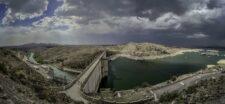Federal officials on Tuesday warned that the Colorado River system is at a “tipping point,” a drought crisis that demands big reductions in water allocation along the river.
The U.S. Interior Department did not announce any mandatory water cuts for New Mexico. But the state’s existing water conservation programs could be under increased scrutiny.
Bureau of Reclamation Commissioner Camille Calimlim Touton said the basinwide cuts are necessary to protect communities that depend on the Colorado for hydropower, irrigation and municipal water supply.
“We talk about protecting the system, about the infrastructure being more resilient,” Touton said. “But what we’re doing today is protecting the people.”
The Colorado River serves more than 40 million people across seven states and Mexico.
Decades of drought are taking a toll across the region.
Lake Powell and Lake Mead, the country’s largest reservoirs, have both dipped to less than 30% of their capacity.
Arizona will bear the brunt of additional water cuts next year.
The state will receive about 592,000 acre-feet less from the river, which is about 21% of the state’s annual allotment.
Nevada and Mexico will also receive less Colorado River water in 2023.
Cuts announced Tuesday are outlined under existing agreements.
But the federal government has authority to implement new reductions if states don’t come up with more ways to cut water use.
“Without action,” Touton said, “we cannot protect the system.”
In June, Touton tasked the seven basin states with creating a plan to conserve an additional 2 to 4 million acre-feet of water — a staggering amount — to protect reservoir levels.
But no such plan had materialized by Tuesday’s deadline.
The Upper Basin Colorado River states of New Mexico, Utah, Colorado and Wyoming released a five-point plan in response to Touton’s call for conservation.
Interior officials said they will support the plan, which focuses on existing programs, including:
- Additional releases from Upper Basin reservoirs to prop up Lake Powell.
- Compensating farmers to fallow fields.
- Enhanced water measuring.
New Mexico is entitled to about 11% of the Colorado River, but the state typically uses only about half of that allocation each year.
Ali Effati, who oversees the Colorado River Basin bureau of the New Mexico Interstate Stream Commission, noted that the state is no stranger to slim water supplies.
“We are already shorted by Mother Nature, and we have been living with those shortages for years,” Effati said. “A combination of water supply shortages and aggressive conservation measures have taught us how to handle crises like this.”
Upper Basin states for the last two years have released additional water from Flaming Gorge, Blue Mesa and Navajo Reservoirs to prop up downstream reservoir levels.
Those emergency releases could continue next year.
Officials also touted a massive influx of water project funds from federal legislation.
The Bipartisan Infrastructure Law includes $8.3 million for Reclamation water infrastructure programs.
The Inflation Reduction Act directs $4 billion to fallowing and irrigation efficiency in the Colorado River Basin and other areas experiencing similar drought.
Basin states will use that funding to hammer out voluntary solutions in a “complex environment,” said Deputy Interior Department Secretary Tommy Beaudreau.
“Everybody has to tighten their belts in this situation,” he said.
In New Mexico, Colorado River drought strategies could prompt more conservation by municipalities and a focus on fallowing farm fields.
“Nobody is off the hook, and we are all in this together,” Effati said. “But it’s important to pay attention to the work that is happening naturally.”


















